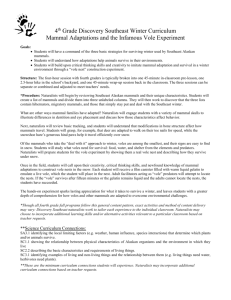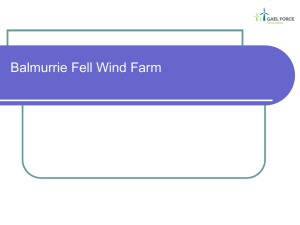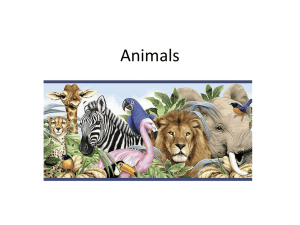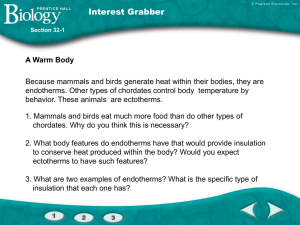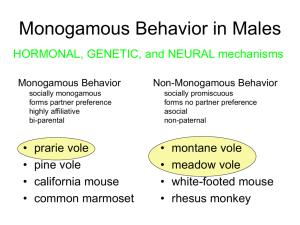Zoogeography
advertisement
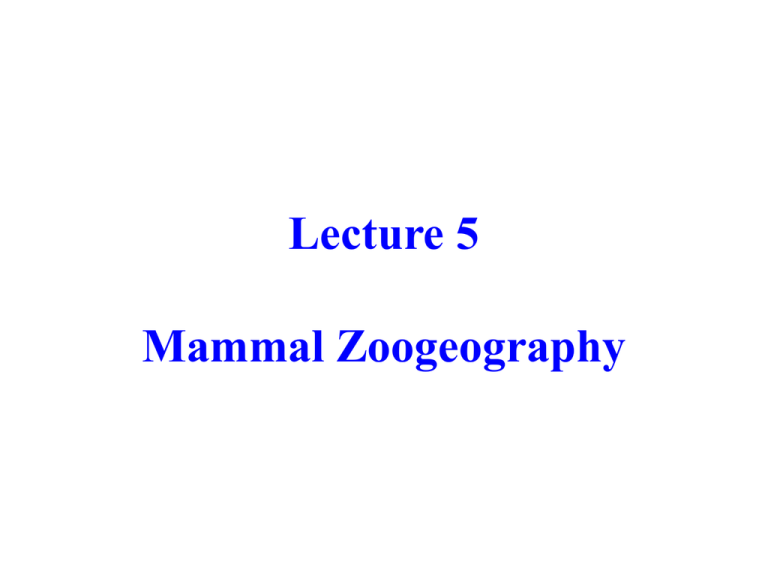
Lecture 5 Mammal Zoogeography 145 MY JURASSIC 215 MY ? Multiturberculata Amphilestidae Triconodontidae Docodontidae ? ? Dryolestidae Paurodontidae Peramuridae PLACENTALS MARSUPIALS ‘K-T boundary’ Amphitheridae Shuotherium Spalacotheriidae Kuehneotheriidae CRETACEOUS Morganucodontidae 65 MY Ornithorhynchidae MONOTREMES CENOZOIC Haramiyoidea Sinoconodontidae Phylogeny of Mesozoic Mammals 0 Yrs ? TRIASSIC (from Carroll 1988, pp. 415) What is Zoogeography? Zoogeography is the study of the geographical distributions of animals Zoogeography seeks answers to questions like: Why are there marsupials in Australia and South America? Why are members of the camel family (Camelidae) found in north Africa and South America? Why are there primates from Japan to Africa, as well as South but not North America? Principles of Ecological Zoogeography Endemism all species have a limited distribution on a world scale. Some mammals are very well dispersed - eg. Humans, their stock, and commensuals like the house mouse (Mus domesticus), whereas others have a very limited distribution. Endemism (occurring nowhere else), or being endemic - a taxon is restricted to a limited geographical area. Endemism depends on the scale you are referring to - it might be a small area like an island, or an entire continent. Endemism can refer to a single species, genus, family, order, or other grouping. Principles of Ecological Zoogeography Convergence when groups of mammals become geographically isolated, they usually diverge meaning they adapt (over a long time span) to the specific climatological, geological and ecological situation they are faced with. However - sometimes convergence occurs - convergence occurs when distantly related lineages inhabiting regions with similar climatological, geological and ecological situations evolve similar morphologies, life history patterns or niche characteristics. Numerous examples of convergence exist among mammals echidna (Tachyglossus) pangolin (Manis) aardwolf (Protoletes) Giant anteater (Myrmecophaga) aardvark (Orycteropus) numbat (Mymecobius) Principles of Ecological Zoogeography Mammals on Islands Islands can be the traditional sort (surrounded by water!), or isolated mountain ranges, deserts, parches of suitable vegetation etc - “habitat islands” Dispersal to islands is a problem for mammals - rodents and bats are the most successful island colonisers - eg. rodents and bats are the only terrestrial eutherians to reach Australia, and the Galapagos Islands. Different selective pressure on islands vs. mainland affects some characteristics of mammals: •niche expansion - ‘competitive release’ •body size - can be larger or smaller than mainland counterparts •behaviour - predator aviodance, etc Principles of Ecological Zoogeography Latitudinal Gradients Species diversity of mammals (and most other life forms) increases along a gradient from the poles to the Equator Several theories proposed : •higher productivity and stability in tropics •greater habitat heterogeneity in tropics •more spp. = > competition & specialization •harder to adapt to colder climates •parasite loads > in tropics 40 50 50 80 100 110 110 110 140 150 150 150 160 Not always the case •seals and baleen whales reach peak diversity at high latitudes •Drylands in Sth America has > diversity of endemics than lowland Amazon r’forest Faunal Regions Palearctic Nearctic Neotropical Ethiopian Oriental Australian Plate Tectonics Plate Tectonics - theory that the earth’s crust, including the continents and ocean floors, is made up of a series of plates, as plates collide volcanoes occur, and may result in oceanic islands, mountain ranges etc. Continental Drift - movement over geological time of the earths large land masses as a result of plate tectonics • Wegener (1912, 1915) but not accepted until 1960s Marsupial Zoogeography Marsupials evolved in North America (diverse fossil evidence from southern Canada & western USA) Dispersed south to South America, Antactica and Australia, and East to Europe & north Africa Gondwana split from Pangaea, and marsupials underwent extensive radiation in relative isolation Marsupials in North America and Europe went extinct, possibly due to radiation and expansion of the Eutherians Antartica drifted south - massive extinction. Australia drifted east, enormous radiation Dispersal and Centres of Origin Passive Dispersal - movements in which the dispersing organism plays no active role in the movement Eg. rafting, or being transported by humans Active Dispersal - involves an accumulation of ecological dispersal events in which individuals move by terrestrial locomotion or flight active long-term species dispersal movements, also called faunal interchanges, occur via several routes. Corridor Route - minimal resistance to the passage of animals (eg. present interconnection of Asia and Europe) Filter Route - allows only certain species to pass through - eg. Beringia. Only mammals adapted to the cold climate could successfully cross between the continents. Sweepstake Route - most restrictive pathway. Involves movement of animals by swimming, flying, rafting or other means . Unlikely to be crossed by large numbers of a given type of animal, but occasional one will make it. Eg. New Guinea to Australia to New Zealand Glaciation and Refugia During the Pleistocene several cool, dry glacial periods, interspersed with warmer and wetter interglacial periods have had a substantial effect of mammal distributions There have been 4 glacial periods in the last 600,000 years, with the most recent one ending approx. 12,000 years ago. We are currently in an interglacial (warm, wet) period During each glacial period, ice sheets expanded and many species were displaced, some driven to extinction. During glacial periods, however, the sea level was lower and some land bridges formed (eg. Bering land bridge) During the interglacial periods, episodes of recolonisation and resettlement occurred, and sea level rose, isolating some species Glaciation and Refugia: Beringia Beringia was a land mass which was largely ice-free during the last glacial period (90,000 - 10,000 years ago) due to its arid climate It acted as a refugium for several mammals, as well as a land bridge for animals to cross between Eurasia and North America (from Pringle 1999) Land bridge was submerged again approx. 11,000 years ago (to the present) Beringia Mammals Steppe bison (Bison priscus) American lion (Panthera leo atrox) Others included: short-faced bears (Artodus) mastodon (Mammut americanum) woolly mammoth (Mammuthus primigenius) Scimitar cat (Hometherium serum) camels (several genera) first humans in North America Jefferson’s ground sloth (Megalonyx jeffersonii) Giant beaver (Casteroides ohioensis) (from Pringle 1999) Beringia Immigrants 1.8 million years ago Mammuthus (mammoth) Synaptomys (bog lemming) Microtus (vole) Ondatra (muskrat) 1.2 million years ago Clethrionomys (red-backed vole) Phenacomys (vole) Synaptomys (bog lemming) Microtus (vole) Bison (Bison) Gulo (wolverine) Smilodon (saber-tooth cat) 170,000 years ago Dicrostonyx (collared lemming) Lemmus (lemming) Lagurus (vole) Microtus (vole) 470,000 years ago Microtus pennsylvanicus (meadow vole) M. montanus (montane vole) Cervalces (extinct stag moose) Rangifer (caribou) Oreamnos (mountain goat) Ovibos (musk ox) Ovis (sheep) Alces (moose) Bos (yak) Saiga (antelope) Bootherium (extinct bovid) 70,000 years ago Clethrionomys rutilis (red-backed vole) Microtus oeconomus (tundra vole) Panamanian Land Bridge Stopped by Filter many bats most armadillos anteaters sloths most histricomorphs Panamanian Land Bridge porcupine nine-banded armadillo Crossed Filter Panamanian Land Bridge Stopped by Filter shrews kangaroo rats pocket gophers beavers bobcats pronghorn antelope bison sheep Panamanian Land Bridge Rabbits squirrels mice dogs bears raccoons weasels otters skunks puma deer Crossed Filter Panamanian Land Bridge Cannot Recross Filter coatis kinkajous tapirs peccaries camels Camelidae Zoogeography Camelidae - Bactrian camels (Camelus bactrianus) and dromedaries (C. dromedarius) occur in north Africa, and llama (Lama glama), alpaca (L. pacos), guanaco (L. guanicoe) and vicuna (Vicugna vicugna) occur in South America Camelids arose and diversified in North America, with some forms eventually dispersing across the Bering Land Bridge (Beringia) to Eurasia and Africa, and the Panamanian Land Bridge to South America North American camelids went extinct towards the end of the last glaciation

